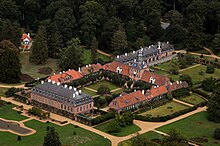Wolfsgarten Castle
The Wolfsgarten Castle is a former hunting lodge in Langen (Hessen) , about 15 km south of Frankfurt .
history

The palace was built as a hunting lodge by Landgrave Ernst Ludwig von Hessen-Darmstadt from 1722 to 1724 according to plans by the chief architect Louis Remy de la Fosse . It corresponded to the then common pattern for hunting locks, which had a boom due to the parforce hunt introduced by Ernst Ludwig in 1709 : a rectangular courtyard around which the mansion, opposite the stables and other buildings to the side were arranged.
Parforce hunting was abolished in 1768, Wolfsgarten Castle was no longer used and fell into disrepair. It was not until 1834 - the demolition of the palace had already been decided - that Grand Duke Ludwig III. of decaying buildings. He had the facility carefully renovated, refurbished and used.
At the beginning of the 20th century the castle underwent extensive renovations and the park was designed. This can include the 1902 by the architect counts Joseph Maria Olbrich for Princess Elizabeth , daughter of the reigning Grand Duke Ernst Ludwig , the Jugendstil built princesses house (also "play house" called). The house and all its furnishings have been reduced in size to the size of the then seven-year-old princess. Today it is the only work by Joseph Maria Olbrich that has remained unchanged.
After the abdication of the Grand Dukes of Hesse and the Rhine in 1918, Wolfsgarten Castle was one of the residences of the former grand ducal family. The last boss of the House of Hessen-Darmstadt, Ludwig von Hessen and near the Rhine, lived here and his widow Margaret lived here until her death in 1997 , then the adopted son and heir Moritz Landgrave von Hessen until his death in 2013 .
After the Princely Garden Festival in September 2013, the side buildings of the hunting lodge were returned to their original condition from 1844 (based on a painting by Ernst August Schnittspahn ) and the stone walls plastered with beige paint again. This measure was also due to the fact that the fragile quarry stone masonry had to be protected from wind and weather. In addition, the 3000 m² roofs were re-covered and their wooden supporting structure was renewed. Similar measures are planned for the Herrenbau and Marstall at a later date.
sightseeing
Today the castle is owned by the Hessian House Foundation and is not freely accessible. Every year on two weekends in May when the rhododendrons are in bloom and three days in September for the “Princely Garden Festival” (Friday to Sunday on the third weekend of the month), Haus Hessen makes the park accessible to visitors. There will also be an ecumenical service in the park on May 1st.
literature
- Rolf Müller (Ed.): Palaces, castles, old walls. Published by the Hessendienst der Staatskanzlei, Wiesbaden 1990, ISBN 3-89214-017-0 , pp. 225–227.
- Georg Ulrich Großmann : Central and South Hesse: Lahntal, Taunus, Rheingau, Wetterau, Frankfurt and Maintal, Kinzig, Vogelsberg, Rhön, Bergstrasse and Odenwald. DuMont, Cologne 1995, ISBN 3-7701-2957-1 (= DuMont art travel guide ), p. 209.
Web links
- Wolfsgarten Castle at gg-online.de
- Wolfsgarten Castle Park
- View of the Wolfsgarten hunting lodge, 1848. Historical views of the town, plans and floor plans. (As of March 29, 2007). In: Landesgeschichtliches Informationssystem Hessen (LAGIS).
- View of the Wolfsgarten hunting lodge near Langen, 1848. Historical views of the town, plans and floor plans. (As of August 6, 2008). In: Landesgeschichtliches Informationssystem Hessen (LAGIS).
Individual evidence
- ↑ Rainer Maaß: The longing for absolutism. The history and art interests of Grand Duke Ludwig III. from Hesse and the Rhine. In: Bernd Heidenreich u. a. (Ed.): Crowns, Wars, Arts. The House of Hesse in the 19th and 20th centuries. Frankfurt 2009, pp. 84-118 (93ff).
- ↑ Langener Zeitung (Offenbach Post) of July 2, 2013: "Back to the past"
- ↑ Homepage Princely Garden Festival
Coordinates: 49 ° 58 ′ 49 ″ N , 8 ° 38 ′ 20 ″ E



